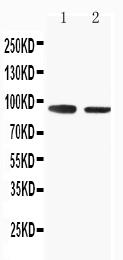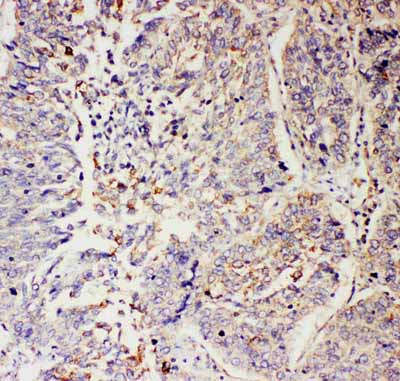Anti-SLC9A2 Antibody
- SPECIFICATION
- CITATIONS
- PROTOCOLS
- BACKGROUND

Application
| WB, IHC-P |
|---|---|
| Primary Accession | Q9UBY0 |
| Host | Rabbit |
| Reactivity | Human, Mouse, Rat |
| Clonality | Polyclonal |
| Format | Lyophilized |
| Description | Rabbit IgG polyclonal antibody for Sodium/hydrogen exchanger 2(SLC9A2) detection. Tested with WB, IHC-P in Human;Mouse;Rat. |
| Reconstitution | Add 0.2ml of distilled water will yield a concentration of 500ug/ml. |
| Gene ID | 6549 |
|---|---|
| Other Names | Sodium/hydrogen exchanger 2, Na(+)/H(+) exchanger 2, NHE-2, Solute carrier family 9 member 2, SLC9A2, NHE2 |
| Calculated MW | 91520 MW KDa |
| Application Details | Immunohistochemistry(Paraffin-embedded Section), 0.5-1 µg/ml, Human, Rat, Mouse, By Heat Western blot, 0.1-0.5 µg/ml, Rat, Human, Mouse |
| Subcellular Localization | Membrane; Multi-pass membrane protein. |
| Tissue Specificity | Expressed in skeletal muscle, colon and kidney. Lower levels in the testis, prostate, ovary, and small intestine. |
| Protein Name | Sodium/hydrogen exchanger 2 |
| Contents | Each vial contains 5mg BSA, 0.9mg NaCl, 0.2mg Na2HPO4, 0.05mg Thimerosal, 0.05mg NaN3. |
| Immunogen | A synthetic peptide corresponding to a sequence at the C-terminus of human SLC9A2(666-684aa RYLSLPKNTKLPEKLQKRR), different from the related rat and mouse sequences by two amino acids. |
| Purification | Immunogen affinity purified. |
| Cross Reactivity | No cross reactivity with other proteins |
| Storage | At -20˚C for one year. After r˚Constitution, at 4˚C for one month. It˚Can also be aliquotted and stored frozen at -20˚C for a longer time.Avoid repeated freezing and thawing. |
| Sequence Similarities | Belongs to the monovalent cation:proton antiporter 1 (CPA1) transporter (TC 2.A.36) family. |
| Name | SLC9A2 (HGNC:11072) |
|---|---|
| Synonyms | NHE2 |
| Function | Plasma membrane Na(+)/H(+) antiporter. Mediates the electroneutral exchange of intracellular H(+) ions for extracellular Na(+) (PubMed:10444453). Major apical Na(+)/H(+) exchanger in the base of the colonic crypt. Controls in the colonic crypt intracellular pH (pHi) to direct colonic epithelial cell differentiation into the absorptive enterocyte lineage at the expense of the secretory lineage (By similarity). |
| Cellular Location | Apical cell membrane; Multi-pass membrane protein |
| Tissue Location | Expressed in skeletal muscle, colon and kidney. Lower levels in the testis, prostate, ovary, and small intestine (PubMed:10444453, PubMed:8843774). In the distal colon, expressed along the cryptal axis (PubMed:8843774). |

Thousands of laboratories across the world have published research that depended on the performance of antibodies from Abcepta to advance their research. Check out links to articles that cite our products in major peer-reviewed journals, organized by research category.
info@abcepta.com, and receive a free "I Love Antibodies" mug.
Provided below are standard protocols that you may find useful for product applications.
Background
Sodium–hydrogen exchanger 2, also called SLC9A2 or NHE2 is a protein that in humans is encoded by the SLC9A2 gene. This gene is mapped to 2q12.1. The Na+/H+ exchangers(NHE) are membrane proteins involved in cell volume. The exchanger(which they called NHE2) is found in several tissues, including intestine and kidney, and is highly expressed in villus and distal convoluted tubules. This gene is involved in pH regulation to eliminate acids generated by active metabolism or to counter adverse environmental conditions. It seems to play an important role in colonic sodium absorption.
If you have used an Abcepta product and would like to share how it has performed, please click on the "Submit Review" button and provide the requested information. Our staff will examine and post your review and contact you if needed.
If you have any additional inquiries please email technical services at tech@abcepta.com.













 Foundational characteristics of cancer include proliferation, angiogenesis, migration, evasion of apoptosis, and cellular immortality. Find key markers for these cellular processes and antibodies to detect them.
Foundational characteristics of cancer include proliferation, angiogenesis, migration, evasion of apoptosis, and cellular immortality. Find key markers for these cellular processes and antibodies to detect them. The SUMOplot™ Analysis Program predicts and scores sumoylation sites in your protein. SUMOylation is a post-translational modification involved in various cellular processes, such as nuclear-cytosolic transport, transcriptional regulation, apoptosis, protein stability, response to stress, and progression through the cell cycle.
The SUMOplot™ Analysis Program predicts and scores sumoylation sites in your protein. SUMOylation is a post-translational modification involved in various cellular processes, such as nuclear-cytosolic transport, transcriptional regulation, apoptosis, protein stability, response to stress, and progression through the cell cycle. The Autophagy Receptor Motif Plotter predicts and scores autophagy receptor binding sites in your protein. Identifying proteins connected to this pathway is critical to understanding the role of autophagy in physiological as well as pathological processes such as development, differentiation, neurodegenerative diseases, stress, infection, and cancer.
The Autophagy Receptor Motif Plotter predicts and scores autophagy receptor binding sites in your protein. Identifying proteins connected to this pathway is critical to understanding the role of autophagy in physiological as well as pathological processes such as development, differentiation, neurodegenerative diseases, stress, infection, and cancer.




